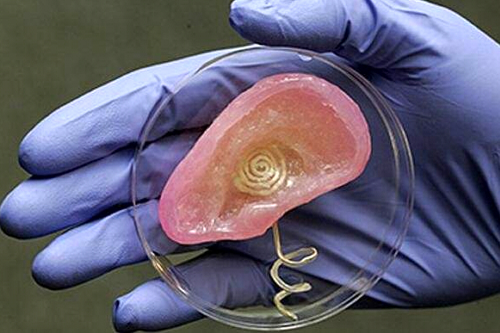Regenerative Medicine: A Tissue of Truths
再生医学:器官真相
The routine printing of human body parts may not be far away
在不远的将来,打印人体组织也许会成为常规
Every year about 120,000 organs, mostly kidneys, are transplanted from one human being to another. Sometimes the donor is a living volunteer. Usually, though, he or she is the victim of an accident, stroke, heart attack or similar sudden event that has terminated the life of an otherwise healthy individual. But a lack of suitable donors, particularly as cars get safer and first-aid becomes more effective, means the supply of such organs is limited. Many people therefore die waiting for a transplant. That has led researchers to study the question of how to build organs from scratch.
每年约有12万个器官(主要是肾脏)从一个人身上移植到另一个人身上。有时器官由仍健在的志愿者捐赠,但通常情况下捐赠者都是因事故、中风、心脏病或类似突然事件而猝然离世的健康人。但因缺少合适的捐赠者,特别是在汽车变得更安全、急救变得更有效的情况下,上述途径供应的器官已十分有限。因此,许多人在等待移植的过程中就去世了。这促使研究人员着手研究从零打造器官的问题。
One promising approach is to print them. Lots of things are made these days by three-dimensional printing, and there seems no reason why body parts should not be among them. As yet, such “bioprinting” remains largely experimental. But bioprinted tissue is already being sold for drug testing, and the first transplantable tissues are expected to be ready for use in a few years’ time.
一个有望成功的方法是3D打印。现在很多东西都是通过3D打印制造出来的,用这项技术来打印人体器官似乎也没什么不可以。到目前为止,这种“生物打印”仍然主要是实验性的,但是生物打印的器官组织已经上市,供药物测试使用。预计第一批可移植的组织可在几年内用于手术。
Bioprinting originated in the early 2000s, when it was discovered that living cells could be sprayed through the nozzles of inkjet printers without damaging them. Today, using multiple print heads to squirt out different cell types, along with polymers that help keep the structure in shape, it is possible to deposit layer upon layer of cells that will bind together and grow into living, functional tissue. Researchers in various places are tinkering with kidney and liver tissue, skin, bones and cartilage, as well as the networks of blood vessels needed to keep body parts alive. They have implanted printed ears, bones and muscles into animals, and watched these integrate properly with their hosts. Last year a group at Northwestern University, in Chicago, even printed working prosthetic ovaries for mice. The recipients were able to conceive and give birth with the aid of these artificial organs.
生物打印起源于21世纪初。当时研究人员发现活体细胞可以通过喷墨打印机的喷嘴喷出而不会受损。今天,使用多个打印头,将不同类型的细胞连同保持细胞结构不变的聚合物一起喷射出来,就可以使细胞一层层沉积,最后结合在一起生长成为活体功能组织。各地的研究人员都在尝试打印肾脏和肝脏组织、皮肤、骨骼和软骨,以及保持人体器官存活所需的血管网络。研究人员已经将3D打印的耳朵、骨骼和肌肉移植给动物,观察它们能否很好地与受体相融合。去年,芝加哥西北大学的一个研究小组甚至打印出了具有生物学功能的卵巢假体并移植到小白鼠体内。接受移植的小白鼠借助这些人工器官得以成功受孕并分娩。
No one is yet talking of printing gonads for people. But blood vessels are a different matter. Sichuan Revotek, a biotechnology company based in Chengdu, China, has successfully implanted a printed section of artery into a monkey. This is the first step in trials of a technique intended for use in humans. Similarly, Organovo, a firm in San Diego, announced in December that it had transplanted printed human-liver tissue into mice, and that this tissue had survived and worked. Organovo hopes, within three to five years, to develop this procedure into a treatment for chronic liver failure and for inborn errors of metabolism in young children. The market for such treatments in America alone, the firm estimates, is worth more than $3bn a year.
现在还没有人讨及为人类打印性腺的问题,但血管就是另一回事了。位于中国成都的生物科技公司四川蓝光英诺已成功将一段3D打印的动脉血管植入猴子体内,这是将该技术应用于人体的试验进程中迈出的第一步。圣地亚哥的公司Organovo也做了类似的尝试。该公司在去年12月宣布已将打印的人体肝脏组织移植到小白鼠体内,移植后的组织成功存活且可正常工作。Organovo希望能在三到五年内把这种手段发展成为一种治疗方案,用以治疗慢性肝衰竭和幼儿先天性代谢缺陷。该公司估计,仅在美国,这种疗法的市场价值每年就超过30亿美元。

Johnson & Johnson, a large American health-care company, is so convinced that bioprinting will transform parts of medical practice that it has formed several alliances with interested academics and biotechnology firms. One of these alliances, with Tissue Regeneration Systems, a firm in Michigan, is intended to develop implants for the treatment of defects in broken bones. Another, with Aspect, a biotechnology company in Canada, is trying to work out how to print parts of the human knee known as the meniscuses. These are crescent-shaped cartilage pads that separate the femur from the tibia, and act as shock absorbers between these two bones – a role that causes huge wear and tear, which sometimes requires surgical intervention.
美国大型保健企业强生公司深信生物打印将改变部分医疗手段,为此它已与相关学术机构和生物科技公司成立若干联盟。其中与密歇根州的“组织再生系统”公司(Tissue Regeneration Systems)的联盟是为了开发用于修补骨折缺损的植入物,另一个和加拿大生物科技公司Aspect的联盟正在试图攻克打印人体膝盖半月板的课题。半月板是将股骨与胫骨分开的新月形软骨垫,在这两块骨头之间起减震器的作用。这使它容易出现严重的磨损和撕裂,有时需要通过外科手术来修复。
More immediately, bioprinting can help with the development and testing of other sorts of treatments. Organovo already offers kidney and liver tissue for screening potential drugs for efficacy and safety. If this takes off it will please animal-rights activists, as it should cut down on the number of animal trials. It will please drug companies, too, since the tissue being tested is human, so the results obtained should be more reliable than ones from tests on other species.
相较之下,会更快实现的是利用生物打印来开发和测试其他类型的治疗手段。 Organovo已经可以提供肾脏和肝脏组织来根据疗效和安全性筛选潜在药物。如果这种方法进展顺利,动物保护主义者会很高兴,因为它应该可以减少动物试验的发生。这一做法也会令制药公司满意,因为测试使用的是人体组织,故而获得的结果应该比来自其他物种的测试结果更可靠。
With similar motives in mind, L’Oréal, a French cosmetics firm, Procter & Gamble, an American consumer-goods company, and BASF, a German chemical concern, are working on printing human skin. They propose to use it to test their products for adverse reactions. L’Oréal already grows about five square metres of skin a year using older and slower technology. Bioprinting will permit it to grow much more, and also allow different skin types and textures to be printed.
出于类似的目的,法国化妆品公司欧莱雅、美国消费品公司宝洁和德国化工企业巴斯夫(BASF)都在研究打印人类皮肤,打算使用打印皮肤来检测自家产品的不良反应。欧莱雅已使用较老旧且低效的技术每年人工培养出约5平方米的皮肤。生物打印将让它得以培养出多得多的人造皮肤,而且还能打印不同类型和肌理的皮肤。
Printed skin might eventually be employed for grafts – repairing burns and ulcers. Plans are also afoot, as it were, to print skin directly onto the surface of the body. Renovacare, a firm in Pennsylvania, has developed a gun that will spray skin stem cells directly onto the wounds of burns victims. (Stem cells are cells that proliferate to produce all of the cell types that a tissue is composed of.) The suggestion is that the stem cells in question will come from the patient himself, meaning that there is no risk of his immune system rejecting the new tissue.
打印皮肤最终或许可用于皮肤移植,以修复烧伤和溃疡造成的损伤。一些想要把皮肤直接打印到人体表面的计划似乎也在进行中。宾夕法尼亚州的Renovacare公司开发了一种皮肤修复枪,可以将皮肤干细胞直接喷射到烧伤病人的伤口上(干细胞可快速增殖,生成构成组织的所有类型的细胞)。这意味着所使用的干细胞将来自患者自身,以令新组织免遭免疫系统的排斥。
The real prize of all this effort would be to be able to print entire organs. For kidneys, Roots Analysis, a medical-technology consultancy, reckons that should be possible in about six years’ time. Livers, which have a natural tendency to regenerate anyway, should also arrive reasonably soon. Hearts, with their complex internal geometries, will take longer. In all cases, though, printed organs would mean that those awaiting transplants have to wait neither for the altruism of another nor the death of a stranger to provide the means to save their own lives.
所有这些努力的真正目标是打印整个器官。医疗技术咨询公司“根源分析”(Roots Analysis)估计打印肾脏应该可在大概六年后实现。肝脏天然就具有再生能力,肝脏打印应该也会较快实现。心脏的内部构造复杂,实现打印将需要更长的时间。不过,在上述各种情况下,打印器官都将让那些等待移植的病人既不再需寄希望于另一个人的无私奉献,也不必再等待一个陌生人的死亡来拯救自己的生命。
英文、中文版本下载:http://www.yingyushijie.com/shop/source/detail/id/401.html








